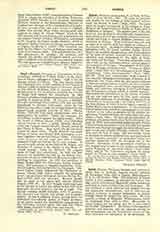

Cahier, CHARLES, antiquarian, b. at Paris, February 26, 1807; d. there February 26, 1882. He made his preparatory studies at the College of Saint-Acheul, and entered the Society of Jesus September 7, 1824. For some years he taught successively in its colleges at Paris, Brieg in the Swiss Canton of Wallis, at Turin, and at Brugelette in Belgium. The greater part of his life, however, was devoted to the collection, classification, and interpretation of the countless treasures of medieval art surviving in France, Belgium, Germany, and elsewhere in Europe. They interested him not only as relics of its artistic skill, but chiefly as evidences of its Catholic faith. As early as 1840 he began his collaboration with his Jesuit confrere, Father Arthur Martin, an excellent draughtsman, and chief collector of the mass of artistic material that Father Cahier classified and interpreted in the light of Catholic faith and theology. Their first important work was a folio on the thirteenth-century stained glass of the cathedral of Bourges, “Monographie de la cathedrale de Bourges, premiere partie. Vitraux du XIIIe siecle” (Paris, 1841-44); the substance of it is in Migne (Guinebaut), “Dist. d’Iconographie” (Paris, 1858), 921-38. Their most characteristic work is found in the valuable “Melanges d’archeologie, d’histoire, et de litterature” etc. (Paris, 1848-56), four quarto volumes of illustrated dissertations on gold and silver church-plate, enamelled ware, carved ivories, tapestries, bas-reliefs, and paintings belonging to the Carlovingian and Romanesque periods (ninth to twelfth century). This important contribution to the history of medieval art was followed later by four more volumes: “Nouveaux melanges d’archeologie, d’histoire, et de litterature sur le moyen-age” etc. (Paris, 1874-77), in the first volume of which is to be found a memoir of Father Martin by his collaborator. In the meantime Father Cahier had published a monograph in two folio volumes on the saints as grasped by the popular imagination, “Caracteristiques des saints dans l’art populaire” (Paris, 1867). In spite of his numerous digressions and parentheses, says Father Brucker (Vacant, II, 1304), and a somewhat neglected style, Father Cahier is never wearisome; a vein of kindly but caustic humor runs through his pages, in which abound pungent words and phrases, dictated, however, by candor and the love of truth. He was deeply versed in all kinds of curious medieval lore, and particularly in the “people’s calendar” or everyday usages and customs connected with the liturgical life of the Church. Specimens of his uncommon erudition in this respect may be seen in his studies on Christmas and on Epiphany in “Ami de la religion” (Paris, 1848-1849), and in his “Calendrier populaire du temps passe” in “Revue de l’art chretien’ (Paris, 1878).
THOMAS J. SHAHAN

